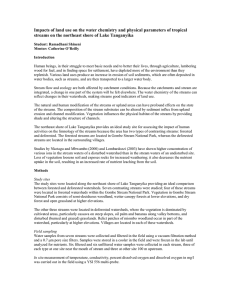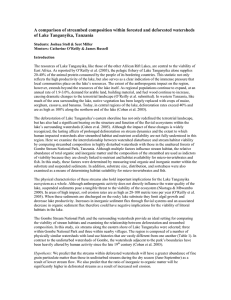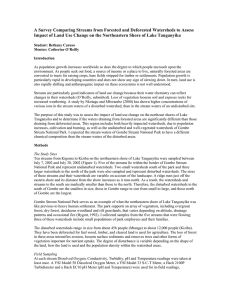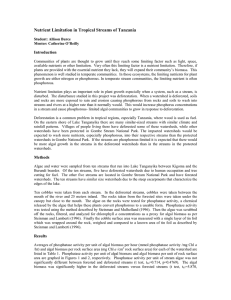Sample Poster
advertisement
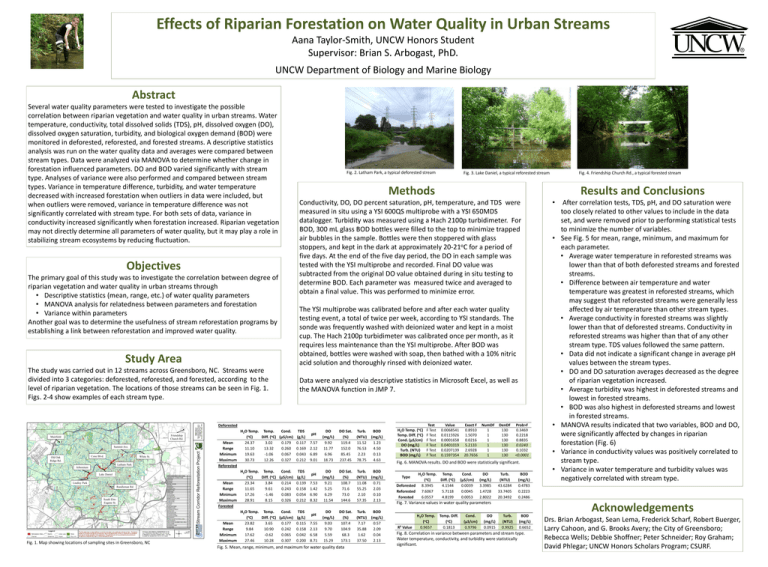
Effects of Riparian Forestation on Water Quality in Urban Streams Aana Taylor-Smith, UNCW Honors Student Supervisor: Brian S. Arbogast, PhD. UNCW Department of Biology and Marine Biology Abstract Several water quality parameters were tested to investigate the possible correlation between riparian vegetation and water quality in urban streams. Water temperature, conductivity, total dissolved solids (TDS), pH, dissolved oxygen (DO), dissolved oxygen saturation, turbidity, and biological oxygen demand (BOD) were monitored in deforested, reforested, and forested streams. A descriptive statistics analysis was run on the water quality data and averages were compared between stream types. Data were analyzed via MANOVA to determine whether change in forestation influenced parameters. DO and BOD varied significantly with stream type. Analyses of variance were also performed and compared between stream types. Variance in temperature difference, turbidity, and water temperature decreased with increased forestation when outliers in data were included, but when outliers were removed, variance in temperature difference was not significantly correlated with stream type. For both sets of data, variance in conductivity increased significantly when forestation increased. Riparian vegetation may not directly determine all parameters of water quality, but it may play a role in stabilizing stream ecosystems by reducing fluctuation. Objectives The primary goal of this study was to investigate the correlation between degree of riparian vegetation and water quality in urban streams through • Descriptive statistics (mean, range, etc.) of water quality parameters • MANOVA analysis for relatedness between parameters and forestation • Variance within parameters Another goal was to determine the usefulness of stream reforestation programs by establishing a link between reforestation and improved water quality. Study Area The study was carried out in 12 streams across Greensboro, NC. Streams were divided into 3 categories: deforested, reforested, and forested, according to the level of riparian vegetation. The locations of those streams can be seen in Fig. 1. Figs. 2-4 show examples of each stream type. Fig. 2. Latham Park, a typical deforested stream Friendship Church Rd. Summit Ave. Cone Blvd. Old Oak Ridge Rd. White St. Latham Park Arboretum Lake Daniel Lindley Park Randleman Rd. South ElmEugene St. Fig. 1. Map showing locations of sampling sites in Greensboro, NC Fig. 4. Friendship Church Rd., a typical forested stream Methods Results and Conclusions Conductivity, DO, DO percent saturation, pH, temperature, and TDS were measured in situ using a YSI 600QS multiprobe with a YSI 650MDS datalogger. Turbidity was measured using a Hach 2100p turbidimeter. For BOD, 300 mL glass BOD bottles were filled to the top to minimize trapped air bubbles in the sample. Bottles were then stoppered with glass stoppers, and kept in the dark at approximately 20-21oC for a period of five days. At the end of the five day period, the DO in each sample was tested with the YSI multiprobe and recorded. Final DO value was subtracted from the original DO value obtained during in situ testing to determine BOD. Each parameter was measured twice and averaged to obtain a final value. This was performed to minimize error. • • The YSI multiprobe was calibrated before and after each water quality testing event, a total of twice per week, according to YSI standards. The sonde was frequently washed with deionized water and kept in a moist cup. The Hach 2100p turbidimeter was calibrated once per month, as it requires less maintenance than the YSI multiprobe. After BOD was obtained, bottles were washed with soap, then bathed with a 10% nitric acid solution and thoroughly rinsed with deionized water. Data were analyzed via descriptive statistics in Microsoft Excel, as well as the MANOVA function in JMP 7. Deforested Muirfield Fig. 3. Lake Daniel, a typical reforested stream H2O Temp. Temp. Cond. TDS pH o o ( C) Diff. ( C) (µS/cm) (g/L) Mean 24.37 3.02 0.179 0.117 7.57 Range 11.10 13.32 0.260 0.169 2.12 Minimum 19.63 -1.06 0.067 0.043 6.89 Maximum 30.73 12.26 0.327 0.212 9.01 Reforested H2O Temp. Temp. Cond. TDS pH (oC) Diff. (oC) (µS/cm) (g/L) Mean 23.34 3.84 0.214 0.139 7.53 Range 11.65 9.61 0.243 0.158 1.42 Minimum 17.26 -1.46 0.083 0.054 6.90 Maximum 28.91 8.15 0.326 0.212 8.32 Forested H2O Temp. Temp. Cond. TDS pH o o ( C) Diff. ( C) (µS/cm) (g/L) Mean 23.82 3.65 0.177 0.115 7.55 Range 9.84 10.90 0.242 0.158 2.13 Minimum 17.62 -0.62 0.065 0.042 6.58 Maximum 27.46 10.28 0.307 0.200 8.71 DO (mg/L) 9.92 11.77 6.96 18.73 DO Sat. (%) 119.4 152.0 85.45 237.45 Turb. (NTU) 11.52 76.53 2.23 78.75 BOD (mg/L) 1.23 4.50 0.13 4.63 DO (mg/L) 9.21 5.25 6.29 11.54 DO Sat. (%) 108.7 71.6 73.0 144.6 Turb. (NTU) 11.08 55.25 2.10 57.35 BOD (mg/L) 0.71 2.03 0.10 2.13 DO (mg/L) 9.03 9.70 5.59 15.29 DO Sat. (%) 107.4 104.9 68.3 173.1 Turb. (NTU) 7.17 35.88 1.62 37.50 BOD (mg/L) 0.57 2.09 0.04 2.13 Fig. 5. Mean, range, minimum, and maximum for water quality data Test H2O Temp. (oC) F Test Temp. Diff. (oC) F Test Cond. (µS/cm) F Test DO (mg/L) F Test Turb. (NTU) F Test BOD (mg/L) F Test Value 0.0068541 0.0115926 0.0001658 0.0401019 0.0207139 0.1597354 Exact F NumDF 0.8910 1 1.5070 1 0.0216 1 5.2133 1 2.6928 1 20.7656 1 DenDF 130 130 130 130 130 130 Prob>F 0.3469 0.2218 0.8835 0.0240 0.1032 <0.0001 • • Fig. 6. MANOVA results. DO and BOD were statistically significant. H2O Temp. Temp. (oC) Diff. (oC) Deforested 8.3945 4.1544 Reforested 7.6067 5.7118 Forested 6.0557 4.8199 Type Cond. (µS/cm) 0.0039 0.0045 0.0053 DO (mg/L) 3.3985 1.4728 2.8022 Turb. (NTU) 43.6284 33.7405 20.3492 BOD (mg/L) 0.4783 0.2223 0.2486 Fig. 7. Variance values in water quality parameters R² Value H2O Temp. (oC) 0.9657 Temp. Diff. (oC) 0.1813 Cond. (µS/cm) 0.9796 DO (mg/L) 0.0915 Turb. (NTU) 0.9925 BOD (mg/L) 0.6652 Fig. 8. Correlation in variance between parameters and stream type. Water temperature, conductivity, and turbidity were statistically significant. • After correlation tests, TDS, pH, and DO saturation were too closely related to other values to include in the data set, and were removed prior to performing statistical tests to minimize the number of variables. See Fig. 5 for mean, range, minimum, and maximum for each parameter. • Average water temperature in reforested streams was lower than that of both deforested streams and forested streams. • Difference between air temperature and water temperature was greatest in reforested streams, which may suggest that reforested streams were generally less affected by air temperature than other stream types. • Average conductivity in forested streams was slightly lower than that of deforested streams. Conductivity in reforested streams was higher than that of any other stream type. TDS values followed the same pattern. • Data did not indicate a significant change in average pH values between the stream types. • DO and DO saturation averages decreased as the degree of riparian vegetation increased. • Average turbidity was highest in deforested streams and lowest in forested streams. • BOD was also highest in deforested streams and lowest in forested streams. MANOVA results indicated that two variables, BOD and DO, were significantly affected by changes in riparian forestation (Fig. 6) Variance in conductivity values was positively correlated to stream type. Variance in water temperature and turbidity values was negatively correlated with stream type. Acknowledgements Drs. Brian Arbogast, Sean Lema, Frederick Scharf, Robert Buerger, Larry Cahoon, and G. Brooks Avery; the City of Greensboro; Rebecca Wells; Debbie Shoffner; Peter Schneider; Roy Graham; David Phlegar; UNCW Honors Scholars Program; CSURF.






